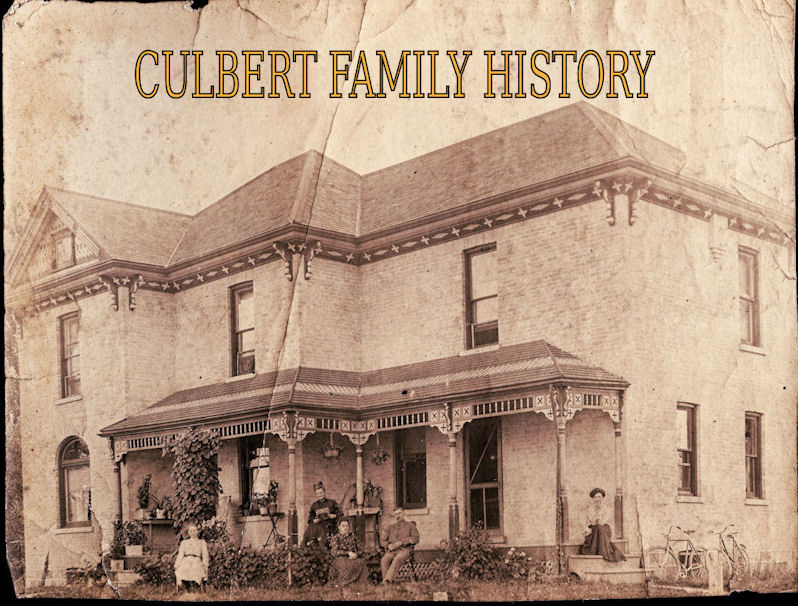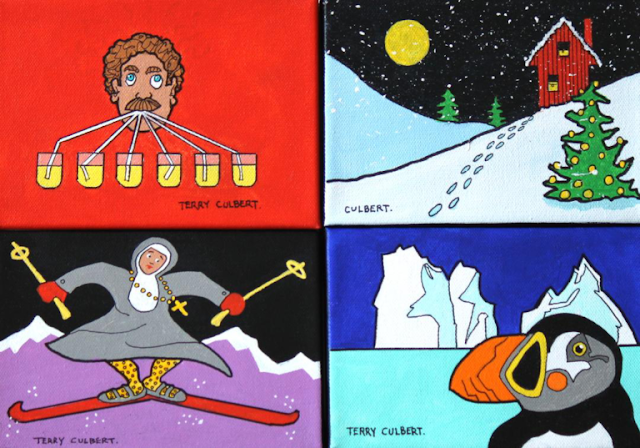Exactly two months before Walter
Herbert’s birth, the Donnelly family were slain just two and a half miles (4
km) from Walter’s parents’ house in Biddulph Township near Lucan, Ontario,
Canada. The Donnelly massacre made international headlines. Twenty years later,
Walter Herbert would make headlines of his own.
Before we get to those headlines,
let’s find out a little more about Walter, and how he fits into the Culbert
family tree.
Walter was described as 5’6”, stout,
with gray/blue eyes and brown hair. I haven’t found a photo so all we have is
this illustration from 1900 …
 |
| Source: The Zurich Herald, 5 October 1900, page 2. |
Walter John Herbert was born 4
April 1880 on Lot 19, Concession 3 in Biddulph Township near Lucan. His parents
were Annie Maria Crawley (c1855-1885) and William Herbert (1852-1901). Annie
Maria Crawley was the granddaughter of John Culbert & Mary Ward.
The Herbert family lived on the Coursey Line, directly
across the road from Poplar Farm, the Culbert homestead
where Walter’s great-grandparents, John Culbert and Mary Ward lived with their
son, Richard Culbert and his family. (We’ll read more about Walter’s
great-uncle, Richard Culbert later in the story.)
%20Crawley%20via%20Lorne%20Brock.jpg) |
| Walter Herbert’s grandmother, Susan (Culbert) Crawley lived one lot over from Poplar Farm, the Culbert homestead. Susan was the daughter of John Culbert & Mary Ward. Photo courtesy of Lorne Brock.
|
The descendants of John Culbert and Mary Ward formed a close-knit community on the Coursey Line. On the farm
beside the Herberts at Lot 20, Concession 3, lived John Culbert and Mary Ward’s
son, Joseph Culbert and his family.
Walter Herbert was only five years old
when his mother, Annie Maria (Crawley) Herbert died on 28 April 1885, the day
after she gave birth to Walter’s sister, also named Annie. Walter’s widowed father,
William Herbert married another woman named Annie. Her maiden name began with
the letter “H” but is illegible on various documents. It may have been Hallorn,
Hallem, Hallaran or some other spelling variation. William and his second wife
had two children: Lucy and George.
In 1900, when Walter Herbert was 20 years
old, he was working as a hired hand on a farm in Arva, Ontario; a hamlet just
five miles north of London. The farm belonged to Jabez Fitzgerald Sifton, known
as Gerald Sifton. Gerald Sifton (1870-1948) was described as a tall, slimly-built man, about 30
years old, with a prepossessing manner.
 |
Walter Herbert worked as a hired hand on Gerald Sifton's farm in Arva.
|
Gerald Sifton’s father was a wealthy,
55-year-old farmer named Joseph Hammersley Sifton. Joseph H. Sifton was born in 1844, the
great-grandson of Charles Sifton and Rebecca Wright who arrived in Canada from
Ireland in 1818.The descendants of Charles and Rebecca created a Canadian
dynasty known for their politicians, businessmen and property developers.
Joseph Sifton’s father was the
1st cousin of John Wright Sifton (1833-1912) who served in the Manitoba
Legislature.
Joseph Sifton had three
particularly illustrious 2nd cousins:
1. Arthur Lewis Watkins Sifton who served as Premier of Alberta
and later became a federal Cabinet minister; 2. Sir Clifford Sifton who was
elected to the Manitoba Legislature and later served in the federal government
where he was responsible for immigration and settlement of the Prairies, and
who also owned the Manitoba Free Press (later known as the Winnipeg Free Press);
and 3. Harry L. Sifton who created London, Ontario’s oldest and largest
home building group, Sifton Properties Ltd.
Joseph Sifton, who had been
married twice previously, was about to be wed to a young woman named Mary
Archanna MacFarlane, about 35 years his junior. Mary MacFarlane was the domestic servant of Joseph’s
son, Gerald Sifton.
Joseph Sifton owned nearly 700
acres of land, 200 of which he had given to his son, Gerald. The balance was
willed to Gerald. However, Gerald caught wind of a rumour that Joseph’s
will would be changed upon Joseph’s marriage to Mary MacFarlane, in favour of
Mary. This arrangement did not sit well with Gerald.
JOSEPH SIFTON MURDERED
ON HIS WEDDING DAY
Joseph Sifton and Mary MacFarlane
were scheduled to marry at 5:00 in the afternoon of 30 June 1900. That morning,
Gerald Sifton went to his father Joseph’s house, with the intent to kill him,
and make it look like an accident. Gerald asked his hired hand, Walter Herbert
to accompany him. Gerald offered Walter $1,000 to act as a witness in the event
that anyone should say that the death of his father was foul play.
Gerald entered his father’s barn,
armed with an axe and a hammer. Up in the hayloft, he knocked some boards off
the top of the barn.
When Joseph came into the barn
and climbed up into the hayloft, Walter struck Joseph with the axe, rendering
Joseph unconscious. Gerald then struck his father’s head with a hammer three or
four times. Joseph fell a distance of 20 feet through the trap door of the barn,
and Gerald struck him a few more times. Walter and Gerald threw Joseph out the
end of the barn.
Initially, Joseph’s death was
considered to be an accident, and he was buried without an investigation. His
death certificate says, “Accident – falling out of barn.”
When rumours began to circulate
about Joseph’s death, his body was exhumed, and two terrible scalp wounds were
discovered. Walter Herbert and Gerald Sifton were arrested in Lucan and charged
with murder.
Walter Herbert confessed to the
crime shortly after he was taken into custody.
 |
Source: The Zurich Herald, 5 October 1900, page 2.
|
 |
Source: Exeter Times, 4 October 1900, page 5.
|
A year later, Gerald Sifton was
brought to trial, then another year went by before Walter Herbert’s account was
heard in court.
Walter Herbert was on the witness
stand for four hours. Here is part of Walter Herbert's testimony, in his own words:
 |
Source: Windsor Star, 5 November 1902, page 1.
|
Gerald Sifton was declared not
guilty and he walked away a free man.
 |
Source: Montreal Star, 10 November 1902.
|
 |
Source: Clinton News-Record, 13 November 1902, page 4.
|
Walter Herbert had confessed to
the crime but he, too, was eventually declared not guilty.
 |
Source: Exeter Advocate, 22 January 1903, page 4.
|
It was believed to be the first
time in the history of Canada that a confessed murderer escaped punishment.
HERBERT VS HERBERT
Walter Herbert’s father, William Herbert
died in 1901 before his son was declared a free man in a court of law. The
shame of having a criminal son must have been overwhelming.
Walter’s father left to him only $5
in his will. Walter's father’s estate comprised 100 acres of land and $1,000 dollars
in insurance money which was left to Walter’s stepmother. An angry Walter
refused to accept the five dollars. Walter hired lawyers, and claimed undue
influence on the part of his stepmother. The defendants were Walter’s
stepmother, and Walter’s great-uncle, Richard Culbert. Richard Culbert, the son
of John Culbert & Mary Ward, lived on the Culbert homestead (Poplar Farm)
across from the Herbert family.
 |
Richard Culbert, a defendant in the will lawsuit. Richard Culbert (1853-1932) was Walter Herbert's great-uncle and lived across the road from the Herbert family on the Coursey Line near Lucan, Ontario.
|
The following clippings show some of the newspaper coverage of the will lawsuit ...
In May 1904 the case was
dismissed, and this was the result as seen in the newspaper …
 |
Walter Herbert lost his case.
|
WHATEVER BECAME OF WALTER
HERBERT & GERALD SIFTON?
In 1904, Walter Herbert was
converted while attending a meeting at the Salvation Army.
,%2016%20Jul%201904,%20page%203.JPG) |
Milton Times (Vermont), 16 July 1904, page 3.
|
That same year, 1904, Walter
Herbert moved to Michigan where he found work as a cement worker, eventually becoming a
cement contractor.
Newspaper clippings show that Walter occassionally returned to Canada to visit friends and family, and that they visited him in Michigan.
 |
This clip shows that in 1947, Walter Herbert of Michigan visited Wilson Wesley Culbert, known as Wes Culbert who lived near Lucan, Ontario. Walter and Wes were first cousins once removed. Source: Exeter Times-Advocate, 3 April 1947, page 10.
|
 |
| This clip shows that Ted Sims and his family of Exeter, Ontario visited Walter Herbert at his home in Belleville, Michigan in 1956. Ted Sims' wife, Eva Pearl (Culbert) Sims was Walter's second cousin, and she was the daughter of Wes Culbert. Source: Exeter Times-Advocate, 30 August 1956, page 3. |
Walter married at least three times. It’s
not clear whether Walter had any children of his own but it appears that at
least two of his wives had children from previous marriages.
Walter died in 1962 age about 82. He is buried with one of his wives, Effie (McKenny) Herbert.
 |
Walter Herbert is buried in Union-Udell Cemetery in Ypsilanti, Michigan.
|
And Gerald Sifton?
Following the
trial, Gerald Sifton moved to New York State to start a new life along with his wife, Mary
Euphemia (Todd) Sifton.
 |
Gerald Sifton's wife, Mary Euphemia (Todd) Sifton (1871-1907).
|
Two children were born to Gerald and Mary in the United
States: John Thomas Clifford Sifton (1903-1990) and Alberta Ethel Sifton
(1905-1948).
Gerald Sifton's wife, Mary died in 1907, age about 36, and is buried at Woodlawn Cemetery in Orchard Park, Erie County, New York, leaving Gerald a widower with two young children.
Sometime between 1915 and 1920, Gerald Sifton and his two children moved
to San Francisco, California, where he worked as a machinist. Later he moved to Los Angeles where he lived with his daughter and son-in-law. Gerald Sifton died in Santa Clara, California on 11
November 1948, age 78. I don't know his burial place.
 |
Gerald Sifton, later in life. Photo from Ancestry.com. I messaged the owner of this photo but never got a reply. If you are the owner of this photo and want it credited or removed, please contact me.
|
Gerald Sifton’s son, John Thomas
Clifford Sifton married Stella Ferguson and they lived in California. Gerald Sifton’s daughter, Alberta
Ethel Sifton married George Denison Dutton, who would go on to become the Sound Director at Paramount
Studios in Los Angeles. George Denison Dutton was nominated for an Oscar in the Best Sound category for Alfred Hitchcock's film, "Vertigo." He also received several other Oscar nominations throughout his career.
UPDATE: Whatever happened to Mary MacFarlane, the young lady who was engaged to the murdered man, Joseph Sifton? Later in life, when she was in her early 40s, she married Joseph's first cousin once removed, William Fitzgerald Guest. William Fitzgerald Guest was the second cousin of Gerald Sifton. Mary (MacFarlane) Guest died in 1927 and is buried in Medway Cemetery in London, Ontario. Mary MacFarlane's brother, George Duncan MacFarlane married a woman named Catherine Anna Christina Colbert; one of the London Township Colberts who is somehow connected to our Culbert families.
Both accused men, Walter Herbert and Gerald Sifton were freed and made new lives for themselves in the United States.
And so ends











%20Crawley%20via%20Lorne%20Brock.jpg)
















%20Herbert%20-%20Richard%20Culbert%20-%20ET%206%20Feb%201902.JPG)
%20Herbert%20-%20Richard%20Culbert%20Huron%20Expositor,%2029%20May%201903,%20page%205.JPG)
%20Herbert%20-%20Richard%20Culbert%20Wingham%20Advance,%204%20Jun%201903,%20page%207.JPG)


,%2016%20Jul%201904,%20page%203.JPG)







